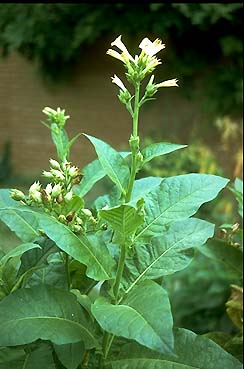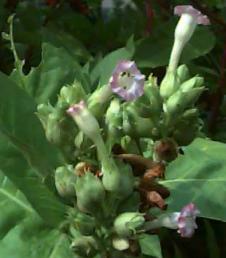Nicotiana spp. (Tobacco and Tree Tobacco)
Distribution and description

Domestic tobacco (N. tabacum ) is widely cultivated throughout the southeast United States. Wild tobaccos (N. attenuata and N. trigonophylla ) are upright, leafy evergreen plants found in sandy, arid regions of the western US. Tree tobacco (N. glauca ) is similar in appearance but can grow to be a small tree and is found at low elevations of Arizona and California.
Tobacco has large, simple, alternate, bright green, often sticky , leaves. Its stems are often sticky and hairy.
Tobacco flowers are organized in panicles. They have a tubular shape with 5 fused petals that flar at the mouth into 5 distinct lobes. they are fragrant and range in color from white to a very light pink, purple, or yellow.

More information describing them is available under the listing for Nicotiana tabacum, Tobacco, in the Canadian Poisonous Plants Information System, courtesy of Derek B. Munro.
This series of web pages was created by an undergraduate student at Cornell University for the AS625 class.
WARNING: These web pages are only meant to be informative. Neither Cornell University nor the author of this site endorse or recommend the use of these plants.